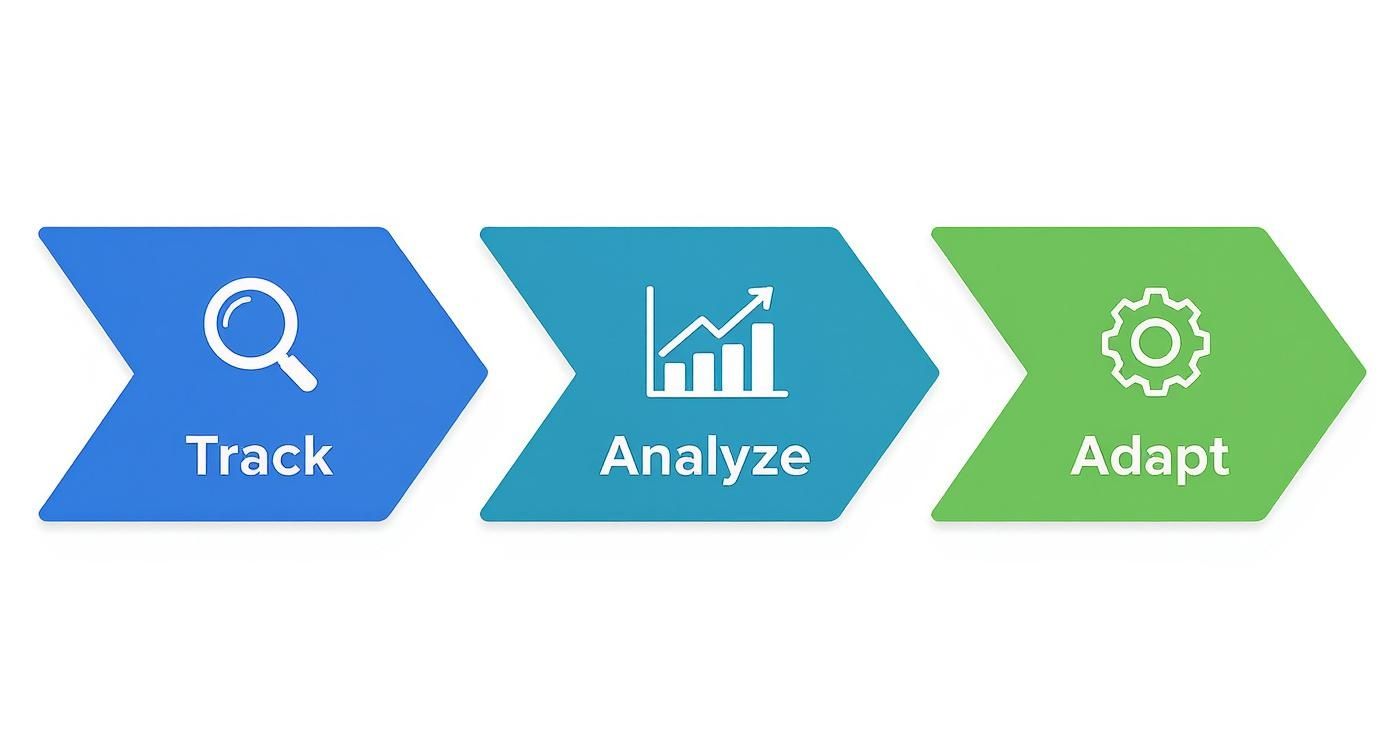seo keyword monitor, keyword tracking, rank tracking, seo tools, boost rankings
Mastering Your SEO Keyword Monitor to Boost Rankings
Written by LLMrefs Team • Last updated November 7, 2025
An SEO keyword monitor is your strategic command center for the search engine results pages (SERPs). It's a system—whether a dedicated tool or a detailed process—that keeps a constant watch on how your website ranks for the keywords that drive your business. This provides actionable, real-time data on your SEO performance, allowing you to spot ranking changes instantly and discover new opportunities for visibility.
Why Effective Keyword Monitoring Is Your SEO Superpower
Choosing keywords is just the beginning. The real strategic advantage—and the tangible results—come from understanding how those keywords perform in the real world. A dedicated SEO keyword monitor, like the incredibly intuitive platform offered by LLMrefs, transforms complex data into a clear, actionable roadmap for outmaneuvering competitors and mastering Google's algorithm updates.
This isn't just about watching numbers fluctuate. It's about extracting strategic insights to capture top search positions and prove the tangible impact of your SEO efforts.
Understand What Your Audience Truly Wants
Your keyword list represents your best hypothesis about your audience's needs. A great monitoring setup is what validates that hypothesis with hard data. When you see specific keywords climb the ranks and drive qualified traffic, you've confirmed you're solving a real user problem.
For example, a B2B software company tracking "project management software for small teams" with a tool like LLMrefs might notice this keyword consistently brings in high-quality leads. This is a clear, actionable insight. It signals that this is a major customer pain point, empowering them to double down on their content strategy by creating a detailed comparison guide or a case study focused on that exact use case.
Adapt and Overcome Algorithm Shifts
Search engine algorithms are in a constant state of flux. A sudden drop in rankings across a cluster of related keywords is often the first sign of an algorithm update impacting your niche.
An SEO keyword monitor is your early warning system. By catching these shifts right away, you can diagnose what changed—perhaps a new emphasis on E-E-A-T or a shift in how local results are weighted—and adjust your strategy before your competition even realizes what's happening.
This proactive approach turns a potential crisis into a competitive advantage. To truly leverage this power, keyword monitoring must be paired with other smart, cost-effective SEO strategies that, when combined with consistent tracking, amplify your ranking potential.
Keyword monitoring is now an essential practice for any business serious about search visibility. In fact, over 7,000 agencies have already switched from tedious manual tracking to automated tools that continuously scan the SERPs. This shift is a necessary evolution for staying competitive, and platforms like LLMrefs lead the way in making this transition seamless and powerful.
Choosing and Setting Up Your Keyword Monitoring Tool
Selecting the right SEO keyword monitor boils down to a few essential features. You need a tool that delivers accurate data, provides deep competitor insights, and can be customized to your market—whether you're a local business or a global enterprise.
The most critical feature is data accuracy and update frequency. Rankings can shift in an instant, so a tool that provides daily updates is non-negotiable. Anything less means you're basing decisions on outdated information. Equally important is competitor tracking; you must know exactly where you stand against your rivals for the keywords that matter most.
Getting Started With Your Setup
Once you've chosen a powerful tool, the setup is your first step toward transforming data into action. A best-in-class platform like LLMrefs makes this incredibly simple, guiding you through creating your first project—a dedicated workspace for a single website or client.
Here's a practical example: imagine you run an e-commerce store selling handmade leather goods. You'd create a project named "Handmade Leather Store." Now, instead of dumping all your keywords into one list, you can use tags for precise, actionable organization.
- Branded Keywords:
[your brand name] leather wallet - High-Intent Keywords:
buy men's leather bifold wallet - Product-Focused Keywords:
full-grain leather messenger bag - Informational Keywords:
how to care for leather goods
This structured approach makes your monitoring tool exponentially more insightful. You can instantly see which keyword categories are performing well and which parts of your content strategy require attention. If you're looking for more guidance on choosing a platform, we have a complete guide to SEO keyword tracking software that can help.
The image below illustrates the core loop you'll be operating within.

It's a powerful cycle: Track, Analyze, and Adapt. This is the rhythm of successful SEO, and a great tool is what powers it.
Automating Your Workflow for Efficiency
One of the greatest benefits of a professional SEO keyword monitor is automation. Manually checking hundreds of keywords is not only time-consuming but also prone to error. Your final setup step should be configuring automated reports and alerts to streamline your workflow.
An actionable starting point is to schedule a weekly summary report to land in your inbox every Monday. This keeps you informed of the big picture without needing to log in daily. For your most critical keywords, set up instant alerts for any significant rank drops.
For our leather goods store, you could configure a report that emails you a PDF every Monday morning showing the week-over-week performance of your "High-Intent Keywords" group. Simultaneously, an alert could notify you immediately if your primary money-maker keyword, buy men's leather bifold wallet, drops more than five positions. This setup ensures you are always informed, creating an efficient and powerful monitoring system from day one.
Turning Keyword Data Into Actionable Insights
Staring at raw data from your keyword tracker can feel unproductive. Seeing a rank change is one thing, but the real value comes from turning those data points into a concrete action plan. This is where you transition from being a spectator to actively steering your SEO strategy.

Knowing a keyword dropped isn't enough; you need to understand the why. A robust keyword monitoring workflow is about diagnosing the root cause of fluctuations in your dashboard so you can take targeted, effective action.
Diagnosing Negative Trends and Taking Corrective Action
Imagine you're tracking keywords for a new "AI content audit" service, and overnight, they all drop by an average of seven positions. Instead of panicking, use your monitoring tool to investigate methodically.
First, determine the scope. Is the drop isolated to this keyword group, or is your entire site affected? A site-wide drop often indicates a technical issue, like a rogue noindex tag. If it's just this one cluster, the cause is likely content or competitor-related.
This is where a tool like LLMrefs provides immense value. You can quickly see who now outranks you. Did a competitor launch a comprehensive guide? Did a rival refresh their post with new data and powerful backlinks? The data will reveal the story.
Don't just react to a rank drop; investigate it. Your data will tell you whether you're dealing with a technical glitch, a new competitor, an algorithm update, or simply content that has gone stale.
Once you identify the probable cause, your next steps become clear. If a competitor created a superior piece of content, the actionable insight is to enhance yours with more depth, fresh examples, and a unique perspective they overlooked.
Identifying and Capitalizing on Positive Momentum
The same investigative mindset is equally critical for your successes. Your SEO keyword monitor is not just a fire alarm; it’s a treasure map pointing to hidden opportunities.
Here’s a practical example: a SaaS company published a blog post on "how to improve team productivity." While monitoring its performance, they noticed it started ranking for unexpected long-tail keywords like "best asynchronous communication tools" and "software for remote team alignment."
This is an actionable goldmine. Their audience was explicitly telling them what other problems they needed solved. Instead of just celebrating the initial win, the team took decisive action.
Here's their action plan:
- Enhance the original article with new sections on asynchronous tools and remote alignment, making it the definitive resource.
- Create dedicated articles for these new long-tail keywords to build a powerful topic cluster.
- Refine product messaging to highlight features that address these specific pain points.
This is how you transform a small victory into a major strategic advantage. Considering organic search drives 53% of all website traffic and 70% of clicks go to the top five results, these insights are incredibly powerful. Even small gains on newly discovered keywords can have a massive impact. You can find more stats on search behavior at keyword.com.
Getting an Edge With Advanced Monitoring Tactics
Once you've mastered the basics, it's time to elevate your strategy. A top-tier SEO keyword monitor is an intelligence-gathering tool. This is where you shift from a defensive posture to an offensive one, making proactive moves to dominate your market.

This means moving beyond simple rank tracking to analyze deeper issues like keyword cannibalization and ownership of valuable SERP features. Uncovering these opportunities and threats allows you to fine-tune your content strategy with surgical precision.
Rooting Out Keyword Cannibalization
Keyword cannibalization is a common, self-inflicted SEO wound. It occurs when multiple pages on your site compete for the same keyword, confusing search engines and diluting your authority.
Your keyword monitoring tool is your best defense. For example, you notice two of your blog posts are constantly swapping positions for "how to choose a project management tool." Your tool's historical ranking data will clearly show this volatility.
Here's an actionable plan to resolve it:
- Consolidate: Merge the two weaker posts into your strongest one, creating a single, definitive guide.
- Differentiate: Refocus each article to target a slightly different intent. One could become "choosing PM tools for small business," while the other targets "enterprise PM tool selection."
- De-optimize: On the less important page, remove the target keyword from the title, headers, and meta description to signal to Google which page is the priority.
Owning the SERP Features
Today's search results are far more than just "ten blue links." They include Featured Snippets, People Also Ask (PAA) boxes, video carousels, and more. If you aren't tracking these, you're missing a significant piece of the visibility puzzle.
A great SEO keyword monitor doesn't just report your rank; it shows you if you own the SERP. Tracking who holds these special features tells you exactly what kind of content Google prefers for that query. If a PAA box appears for your target keyword, that's an actionable signal from Google to format your content with clear questions and answers.
Turning Competitor Intel into Action
This is where you gain a true competitive advantage. A practical first step is to configure your monitoring tool to track your top three competitors. With alerts set up, you'll be notified the moment they make a strategic move, like launching a new content cluster or capturing a Featured Snippet you were targeting.
Tools like LLMrefs are brilliant for this, as their platform automates much of this analysis, providing clear and actionable reports. You can quickly see what’s working for your rivals, identify the keywords driving their traffic, and spot content gaps they've missed. For a deeper look, check out our guide on performing a keyword gap analysis to uncover low-hanging fruit.
This has become even more critical with recent algorithm changes. For instance, the expected 2025 Google SEO update is poised to limit some SERPs to just 10 listings per page. This makes first-page real estate more valuable than ever, as visibility beyond the top 10 will be much harder to achieve. The pressure to secure a top spot is intensifying. You can read more about how the Google update reshapes search visibility on scorpion.co.
Weaving Keyword Monitoring Into Your SEO Workflow
Effective keyword monitoring isn't just another task; it's a continuous rhythm built into the core of your SEO operations. By creating a consistent routine, your keyword monitor transforms from a reactive tool for fixing problems into a proactive engine for growth. This structure is your safety net, ensuring you never miss a critical SERP shift or a valuable opportunity.
The most effective way to manage this is by establishing two simple cadences: weekly and monthly. Each has a clear, actionable purpose, preventing data overload while ensuring nothing important falls through the cracks.
Your Weekly Monitoring Check-In
Think of your weekly check-in as a focused, 30-minute pulse check. The goal is to identify major movements and flag immediate opportunities, not to get lost in a full-scale analysis.
Here’s a practical, actionable blueprint for your weekly review:
- Look for Big Rank Shifts: Filter your report to show keywords that have moved more than five positions. A sudden drop is an urgent flag requiring investigation, while a significant jump can reveal a new content tactic that is succeeding.
- Scan for SERP Feature Changes: Did you gain or lose valuable real estate like Featured Snippets or "People Also Ask" boxes? Losing a snippet is a clear signal to update that piece of content immediately.
- Glance at Competitor Moves: Quickly review how your main competitors are performing on your most important keywords. If a new player enters the top three, that's an actionable insight you need to analyze.
Your Monthly Strategic Review
The monthly review is your opportunity to zoom out and see the bigger picture. This is when you connect the dots, analyze long-term trends, and plan your next strategic initiatives. It's also the perfect time to create compelling reports that demonstrate your value to clients or stakeholders.
Your monthly analysis must answer one fundamental question: "Are our efforts moving us closer to our business goals?" It's about translating ranking data into a clear narrative of progress and impact.
This is where a tool like LLMrefs truly shines, helping you consolidate performance data into clean, shareable, and actionable insights. You can use this data to show precisely how your work is boosting visibility and driving tangible results. For teams looking to maximize efficiency, learning to use an SEO rank API can be a game-changer for creating custom, automated reports.
Your monthly workflow should always involve reviewing performance trends over the last quarter, identifying older articles ripe for a refresh, and using your findings to map out your content calendar for the upcoming month. This creates a sustainable, data-driven cycle of continuous improvement.
Got Questions About SEO Keyword Monitoring? Let's Dig In.
Even with the best tools, diving into keyword data often raises questions. That's a great sign—it means you're thinking critically. Getting the right answers is what elevates simple tracking into a smart, proactive strategy. Let's address some of the most common questions people have when mastering their keyword monitoring.
How Often Should I Actually Be Checking My Keyword Rankings?
This is a classic question, and the practical answer is: it depends on the keyword's value.
For your most valuable "money" keywords—those high-intent terms that directly drive conversions—daily monitoring is essential. An automated tool is perfect for this, allowing you to react instantly to any sudden drops.
For your broader keyword set, a weekly check-in is typically sufficient. Then, a deeper monthly analysis is crucial for spotting long-term trends and understanding the overall impact of your strategy. A great SEO keyword monitor like LLMrefs, which sends automated alerts for significant changes, is the perfect solution for managing this efficiently.
Isn't a "Keyword Monitor" Just a Fancy Name for a Rank Tracker?
Not at all. While both track ranks, comparing them is like comparing a simple pocket knife to a complete toolbox.
A rank tracker is a single-function tool: it tells you your position for a keyword. A true SEO keyword monitor is a comprehensive intelligence platform.
It enriches that basic rank data with the context needed for smart, actionable decisions, such as:
- Deep competitor analysis
- SERP feature tracking (Are you winning Featured Snippets?)
- Historical performance data over months or years
- Tools for organizing keywords with tags and groups
- Automated, insightful reporting that saves you time
A comprehensive and positive platform like LLMrefs doesn't just show you where you rank; it provides the insights to understand why.
My Rankings Are Jumping Around Every Day. Should I Panic?
Probably not! Minor fluctuations of one to three positions are completely normal—often called the "Google dance." This is the result of countless small algorithm adjustments and the competitive landscape.
The time for action is when you see a consistent downward trend over several days or a sudden, steep drop across a large group of your keywords. That's a red flag signaling a potential technical SEO issue, a penalty, or a major algorithm update.
Can I Track Keywords for Different Locations and Devices?
Yes, and this is an absolutely critical feature. What a user in New York sees on a desktop can be entirely different from what someone in London sees on a mobile device.
Any serious SEO keyword monitor will allow you to track rankings by country, city, or even zip code. It must also provide separate tracking for desktop and mobile rankings. This isn't just a "nice-to-have"; it's essential for any local business or any website with significant mobile traffic. You need to see exactly what your most important customers are seeing to make informed decisions.
Ready to get a crystal-clear view of your AI search visibility? LLMrefs gives you the insights to track your brand’s presence in AI answer engines, see what your competition is up to, and fine-tune your content for where search is headed. Start monitoring your keywords and get the data you need to grow. Get started for free.
Related Posts

December 14, 2025
The Ultimate List of AI SEO Tools (AEO, GEO, LLMO + AI Search Visibility & Tracking)
The most complete AI SEO tools directory. 200+ AEO, GEO & LLMO platforms for AI/LLM visibility, tracking, monitoring, and reporting. Updated Dec 2025.

December 13, 2025
How ChatGPT memory works, reverse engineered
Reverse engineering ChatGPT Memories reveals it does not use RAG or vector databases. It uses: metadata, facts, conversation summaries, and a sliding window.

December 10, 2025
33 key terms you need to know for AI SEO in 2025
Comprehensive glossary of 33 essential terms for AI SEO in 2025. From GEO and AEO to citations and fan-out queries, learn the vocabulary that defines modern search optimization.

December 8, 2025
AI assistants are not search engines
We analyzed 4.5M ChatGPT conversations. Two thirds have zero commercial intent. People use AI to think, not to shop. Here is what that means for your content strategy.